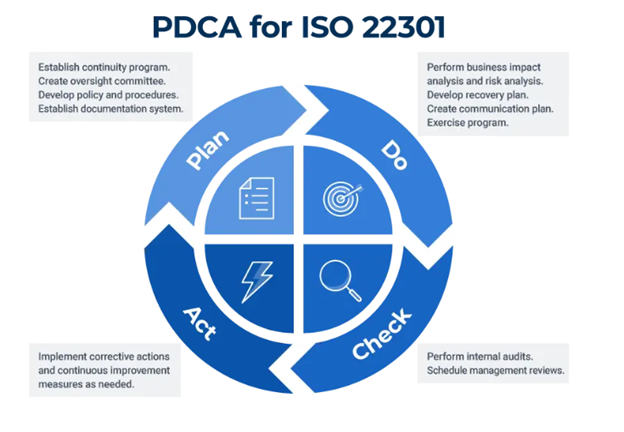What is ISO 22301?
The ISO 22301 is a global standard for business continuity planning requirements to help organizations protect themselves against disruptions. The most current version is 22301:2019, Security and resilience – Business continuity management systems – Requirements.
The concept of business continuity was borne out of the IT boom of the 1980s and 1990s. Public and private organizations realized the need to ensure continuity of service and key supplies and to mitigate the effects of disruptive events.
ISO’s consensus-based standards, such as 22301, cover practices and industries ranging from quality management, IT service, and food safety to environmental safety and information security.
For ISO 22301, the standard provides a consistent BCMS framework and a universal language among organizations for communicating about continuity and aligning processes.

What is the structure of ISO 22301?
The requirements in ISO 22301 address disruptive incidents that can be natural or human-made, widespread or local, intentional or unintentional, such as a snowstorm, a broken water main, an epidemic, a data breach, or a phishing attack.
Consider these specific benefits to using ISO 22301 business continuity planning:
-
- Protect against and recover from disruptive incidents.
- Identify and control current and future threats.
- Improve your risk management planning efforts.
- Prevent large-scale damage.
- Become proactive in preventing problems and recovering from incidents, rather than reactive to damage and disruption.
- Reduce downtime and increase recovery time.
- Keep important activities running during disruption.
- Deliver quality products consistently.
- Provide dependable service.
- Prove you’re a reputable supplier.
- Prove your resilience to all stakeholders.

ISO 22301 and PDCA
Each segment of the PDCA (plan-do-check-act) cycle for continuous improvement corresponds to at least one ISO 22301 clause. Organizations can use ISO 22301 to test continuity procedures, review outcomes, and implement updates or fix problems in a continuous cycle that leads to an increasingly resilient business continuity system.

BCM Lifecycle ISO 22301
The business continuity management (BCM) lifecycle represents industry best practices and some of the core requirements of ISO 22301. These practices offer a solid foundation for resilience, while offering flexibility to adapt to changes in the organization. Guided by leadership, these are the key activities for the lifecycle:
- Conduct a business impact analysis and risk assessment.
- Establish a business continuity strategy.
- Establish and implement business continuity procedures.
- Exercise and test the procedures regularly before a disruption occurs.

